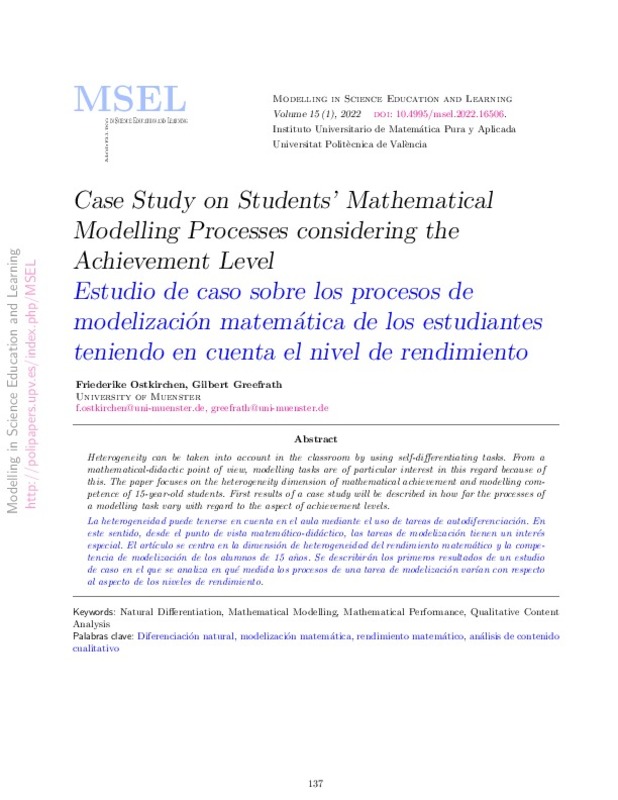Achmetli, K., & Schukajlow, S. (2019). Multiple Solutions, The Experience of Competence, and Interest. In M. S. Hannula, G. C. Leder, F. Morselli, M. Vollstedt, & Q. Zhang (Eds.), Affect and Mathematics Education (pp. 39-65). Cham: Springer International Publishing. https://doi.org/10.1007/978-3-030-13761-8_3
Bergman Ärlebäck, J., & Bergsten, C. (2010). On the Use of Realistic Fermi Problems in Introducing Mathematical Modelling in Upper Secondary Mathematics. In R. Lesh, P. L. Galbraith, C. R. Haines, & A. Hurford (Eds.), Modeling Students' Mathematical Modeling Competencies (pp. 597-609). Boston, MA: Springer US. https://doi.org/10.1007/978-1-4419-0561-1_52
Blum, W. & Leiß, D. (2007). How do students and teachers deal with mathematical modelling problems? The example sugarloaf and the DISUM project. In C. Haines, P. L. Galbraith, W. Blum & S. Khan (Eds.), Mathematical modelling (ICTMA 12). Education, engineering and economics (pp. 222-231). Chichester, England: Horwood. https://doi.org/10.1533/9780857099419.5.221
[+]
Achmetli, K., & Schukajlow, S. (2019). Multiple Solutions, The Experience of Competence, and Interest. In M. S. Hannula, G. C. Leder, F. Morselli, M. Vollstedt, & Q. Zhang (Eds.), Affect and Mathematics Education (pp. 39-65). Cham: Springer International Publishing. https://doi.org/10.1007/978-3-030-13761-8_3
Bergman Ärlebäck, J., & Bergsten, C. (2010). On the Use of Realistic Fermi Problems in Introducing Mathematical Modelling in Upper Secondary Mathematics. In R. Lesh, P. L. Galbraith, C. R. Haines, & A. Hurford (Eds.), Modeling Students' Mathematical Modeling Competencies (pp. 597-609). Boston, MA: Springer US. https://doi.org/10.1007/978-1-4419-0561-1_52
Blum, W. & Leiß, D. (2007). How do students and teachers deal with mathematical modelling problems? The example sugarloaf and the DISUM project. In C. Haines, P. L. Galbraith, W. Blum & S. Khan (Eds.), Mathematical modelling (ICTMA 12). Education, engineering and economics (pp. 222-231). Chichester, England: Horwood. https://doi.org/10.1533/9780857099419.5.221
Borromeo Ferri, R. (2006). Theoretical and empirical differentiations of phases in the modelling process. ZDM, 38(2), 86-95. https://doi.org/10.1007/BF02655883
Borromeo Ferri, R. (2007). Personal experiences and extra-mathematical knowledge as an influence factor on modelling routes of pupils. In Pitta-Pantazi, D; Philippou, G. (Eds.): CERME 5 - Proceedings of the Fifth Congress of the European Society for Research in Mathematics Education. Larnaca, Zypern. (pp. 2080-2089).
Borromeo Ferri, R. (2018). Learning How to Teach Mathematical Modeling in School and Teacher Education. Cham: Springer International Publishing. https://doi.org/10.1007/978-3-319-68072-9
Büchter, A. & Leuders, T. (2005). Mathematikaufgaben selbst entwickeln. Lernen fördern - Leistung überprüfen. Berlin: Cornelsen Scriptor
Cohen, J. (1968). Weighted kappa: Nominal scale agreement provision for scaled disagreement or partial credit. Psychological Bulletin, 70(4), 213-220. https://doi.org/10.1037/h0026256
https://doi.org/10.1037/h0026256
Kaiser, G. (2007). Modelling and Modelling Competencies in School. In C. R. Haines, P. L. Galbraith, W. Blum, & S. Khan (Eds.), Mathematical Modelling (ICTMA 12): Education, Engineering and Economics (pp. 110-119). Chichester: Horwood. https://doi.org/10.1533/9780857099419.3.110
Maaß, K. (2005). Barriers and opportunities for the integration of modelling in mathematics classes: Results of an empirical study. Teaching Mathematics and Its Applications, 24(2-3), 61-74. https://doi.org/10.1093/teamat/hri019
Maaß, K. (2007). Mathematisches Modellieren. Aufgaben für die Sekundarstufe I. Berlin: Cornelsen Scriptor.
Maaß, K. (2010). Classification Scheme for Modelling Tasks. Journal für Mathematik-Didaktik, 31(2), S. 285-311. https://doi.org/10.1007/s13138-010-0010-2
Mayring, P. (2014). Qualitative content analysis: theoretical foundation, basic procedures and software solution. Klagenfurt. Retrieved August 8, 2020, from https://nbn-resolving.org/urn:nbn:de:0168-ssoar-395173.
Ministerium für Schule und Weiterbildung des Landes Nordrhein-Westfalen (2016). Kerncurriculum für Lehrämter in den Zentren für schulpraktische Lehrerausbildung und in den Ausbildungsschulen.
Niss, M., Blum, W., & Galbraith, P. (2007). Introduction. In W. Blum, P.L. Galbraith, H.-W. Henn & M. Niss (Eds.), Modelling and applications in mathematics education (pp. 3-32). The 14th ICMI study. Boston: Springer. https://doi.org/10.1007/978-0-387-29822-1_1
Reusser, K., Pauli, C. & Waldis, M. (Eds.) (2010): Unterrichtsgestaltung und Unterrichtsqualität - Ergebnisse einer internationalen und schweizerischen Videostudie zum Mathematikunterricht. Münster: Waxmann.
Reilly, E. (2017). Developing a Mathematical Modelling Task for All Students. In G. A. Stillman, W. Blum, & G. Kaiser (Eds.), Mathematical Modelling and Applications (pp. 443-453). Cham: Springer International Publishing. https://doi.org/10.1007/978-3-319-62968-1_37
Reit, X.-R., & Ludwig, M. (2015). An Approach to Theory Based Modelling Tasks. In G. A. Stillman, W. Blum, & M. Salett Biembengut (Eds.), Mathematical Modelling in Education Research and Practice (pp. 81-91). Cham: Springer International Publishing. https://doi.org/10.1007/978-3-319-18272-8_6
Scherer, P. & Krauthausen, G. (2010). Natural Differentiation in mathematics - the NaDiMa project. Panama-Post, 29(3), 14-16. https://doi.org/10.1007/978-3-642-13990-1_3
Schnell, S., & Prediger, S. (2017). Mathematics Enrichment for All - Noticing and Enhancing Mathematical Potentials of Underprivileged Students as An Issue of Equity. EURASIA Journal of Mathematics, Science and Technology Education, 13(1). https://doi.org/10.12973/eurasia.2017.00609a
Scott-Wilson, R., Wessels, D. C. J., Wessels, H. M., & Swart, E. (2017). The Hidden Benefits of Mathematical Modelling for Students with Disabilities. In G. A. Stillman, W. Blum, & G. Kaiser (Eds.), Mathematical Modelling and Applications (pp. 455-465). Cham: Springer International Publishing. https://doi.org/10.1007/978-3-319-62968-1_38
Shade, D. D. (1991). Developmentally appropriate software. Day Care & Early Education, 18(4), 34-36. https://doi.org/10.1007/BF01617296
Staples, M. E. (2008). Promoting student collaboration in a detracked, heterogeneous secondary mathematics classroom. Journal of Mathematics Teacher Education, 11(5), 349-371. https://doi.org/10.1007/s10857-008-9078-8
Stender, P., & Kaiser, G. (2015). Scaffolding in complex modelling situations. ZDM, 47(7), 1255-1267. https://doi.org/10.1007/s11858-015-0741-0
Schmidt, S., Ennemoser, M. & Krajewski, K. (2013). DEMAT 9. Deutscher Mathematiktest für neunte Klassen. Göttingen: Hogrefe Verlag.
Siller, H.-S., & Greefrath, G. (2020). Modelling Tasks in Central Examinations Based on the Example of Austria. In G. Stillman, G. Kaiser, & C. E. Lampen (Eds.), Mathematical Modelling Education and Sense-making (pp. 383-392). Cham: Springer International Publishing. https://doi.org/10.1007/978-3-030-37673-4_33
Westfälische Nachrichten (2014): Aktion der Werbegemeinschaft. Es weihnachtet vorm Rathaus. Beitrag in den Westfälischen Nachrichten vom 24.11.2014. Retrieved January 19, 2020, from: https://www.wn.de/Muensterland/Kreis-Steinfurt/Metelen/2014/11/1800209-Aktion-der-Werbegemeinschaft-Es-weihnachtet-vorm-Rathaus
[-]









